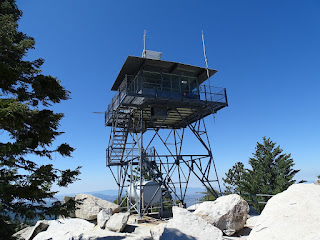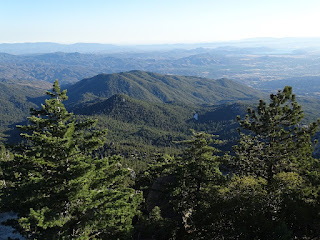 |
| Allen's Hummingbird |
Searching for birds in the winter takes a bit more effort. Many have left the area for warmer climates and they are harder to find since they are much quieter. If you have a backyard feeder and/or water dish, you will easily be able to watch birds from the warmth of your home. However, if you want to find some birds that don't frequent your yard, you will definitely need to put on some layers and go searching.
In the San Jacinto Mountains, there are still some Anna's Hummingbirds (Calypte anna) visiting hummingbird feeders but this dazzler won't be seen in our mountains. It is a coastal bird. We found this one close to the Tijuana border at the Tijuana River Valley Regional Park - Bird and Butterfly Garden. It is listed as the 4th top birding hotspot in San Diego county. Lots of rare birds find their way to this place. Although this hummingbird isn't a rare one, it was fun for me to see the sun capture his shimmering golden gorget.
 |
Orange-crowned Warbler
|
An Orange-crowned Warbler was also enjoying this flowering bush. These warblers forage on insects and berries. However, they are also known to visit sap wells created by Red-naped Sapsuckers (Gilbert, Sogge & Riper. 2020). I watched this warbler pierce the base of several flowers. Perhaps, it has figured out how to get nectar from the base of the blooms like Verdins (Auriparus flaviceps) (Webster, 2020). A brilliant technique if you don't have a long tongue like a hummingbird.
Checking out watering holes is another great place to find birds especially wintering ducks. On this quest, I went to a small pond in a local golfing community in Borrego Springs. Last year, I saw lots of ducks including Hooded Mergansers (Lophodyes cucullatus) and Northern Pintails (Anus acuta).
 |
Green Heron
|
This year, I saw a few Ring-necked Ducks and a statuesque Green Heron patiently waiting for the opportunity to spear its next meal.
 |
Vermilion Flycatcher
|
In contrast to the Green Heron, this flycatcher gave me about 10 seconds before flying to its next perch in search of insects. This pattern continued over and over. I'm sure I provided plenty of head wagging to any non-birder who happened to observe me zigzag back and forth, back and forth, following this beauty around until I could get a photo.
This is the sycamore tree at Rancho Penasquitos in San Diego where a Lewis's Woodpecker is hanging out for the winter. I've mentioned before that it is one of my favorite woodpeckers. It's definitely a dazzler especially when the sun hits its feathers just right.
 |
Lewis's Woodpecker
|
I had a chance to go back to this local park to see if it was still hanging out. Large numbers of them were at Lake Hemet and the surrounding area in 2017 and 2018. In 2020, we spotted one in Garner Valley. It's been a couple of years of waiting to see another one. It definitely was worth the effort for me to see this rare beauty once again. It will depart in the Spring and who knows when I'll see another one.
 |
Grey-crowned Crane
|
One day perhaps we will see one of these cranes in the wild with my cousin, Bud, and his wife, Juliette in Kenya. I absolutely love cranes! Fortunately, we don't have to travel to Africa; we can visit our local zoos like the Living Desert in Palm Springs to see these magnificent birds. If you want to see all of the cranes of the world with only one destination, go to International Crane Foundation in Baraboo, Wisconsin. It's definitely an inspiring place to visit and a great organization to support as they help communities around the world come up with solutions to help protect these endangered birds.
Enjoy your wintering birds! Photos and content by Robin Roberts
Click on photos to enlarge.
References
Gilbert, W. M., M. K. Sogge, and C. van Riper (2020). Orange-crowned Warbler (Leiothlypis celata), version 1.0. In Birds of the World (P. G. Rodewald, Editor). Cornell Lab of Ornithology, Ithaca, NY, USA.
International Crane Foundation https://icfdn.org/
Living Desert https://www.livingdesert.org/
Webster, M. D. (2020). Verdin (Auriparus flaviceps), version 1.0. In Birds of the World (A. F. Poole and F. B. Gill, Editors). Cornell Lab of Ornithology, Ithaca, NY, USA.
















.jpeg)







%20-%20Copy.jpeg)










